
He has his own bach a little north of Whangārei with east coast "pōhutukawa vibes" where he spent time writing his latest cook book — an update to his popular Eat Up New Zealand.
"I spend as much time up here as I possibly can. All of January and any holiday periods see a steady procession of family, friends and whanau come and go."
The rest of the year he spends a lot of time there by himself. As he rents a small apartment in downtown Auckland, he considers the bach "my actual home".
"The juxtaposition couldn’t be more pronounced. While I love city living, I need to balance the sirens, late-night screams and rubbish trucks with solitude, nature and sunsets. It’s critical to my mental game to get away from the masses, with the silence and the tranquility giving me peace of mind."
Brown was introduced to baches as a child on holidays to Castlepoint Campground where his friends had a bach — his family stayed in an old wooden caravan they nick-named "The Pie-Cart".
"I find baches such sensory dwellings . . . from every angle their individual unique character is evident. And not just from the outside, but also from the inside looking out."
But the room that inspires the most affection is the kitchen, a space in any abode, he says, that embodies and welcomes all the senses. In a crib it is the heart and hub.
"I often speak about the importance of people and place and how those two simple ingredients — who you are with and where you are physically located — play such a significant role in our most vivid and influential food memories."

He has updated Eat Up New Zealand (2017) with the The Bach Edition.
"My philosophy around how I like to cook and serve hasn’t changed much at all in the past 20 years. I have never really been swayed by trends that become popular for a time, then come and go over the years. I am always inspired by clever food, no matter where it comes from."
His two main drivers when cooking are "generosity" and "fun".
"Bach food is all about that . . . it is not complicated, it doesn’t require a trip to a specialty food store or taking out a second mortgage to purchase a bloody sous vide machine etc. It is about feeding loved ones who are famished with food that is simple, fresh, delicious and, thank goodness, sometimes a little down and dirty."
So he has created some new recipes while at the bach to go with the classics from the original book.
"They are all approachable, doable and deliciously edible, as are all the originals. I like to make a bunch of pre-holiday preps to have on hand to save time and make things a little easier."
THE BOOK
Recipes extracted from Eat Up New Zealand: The Bach Edition by Al Brown, photography by Josh Griggs, published by Allen & Unwin NZ, RRP $49.99.
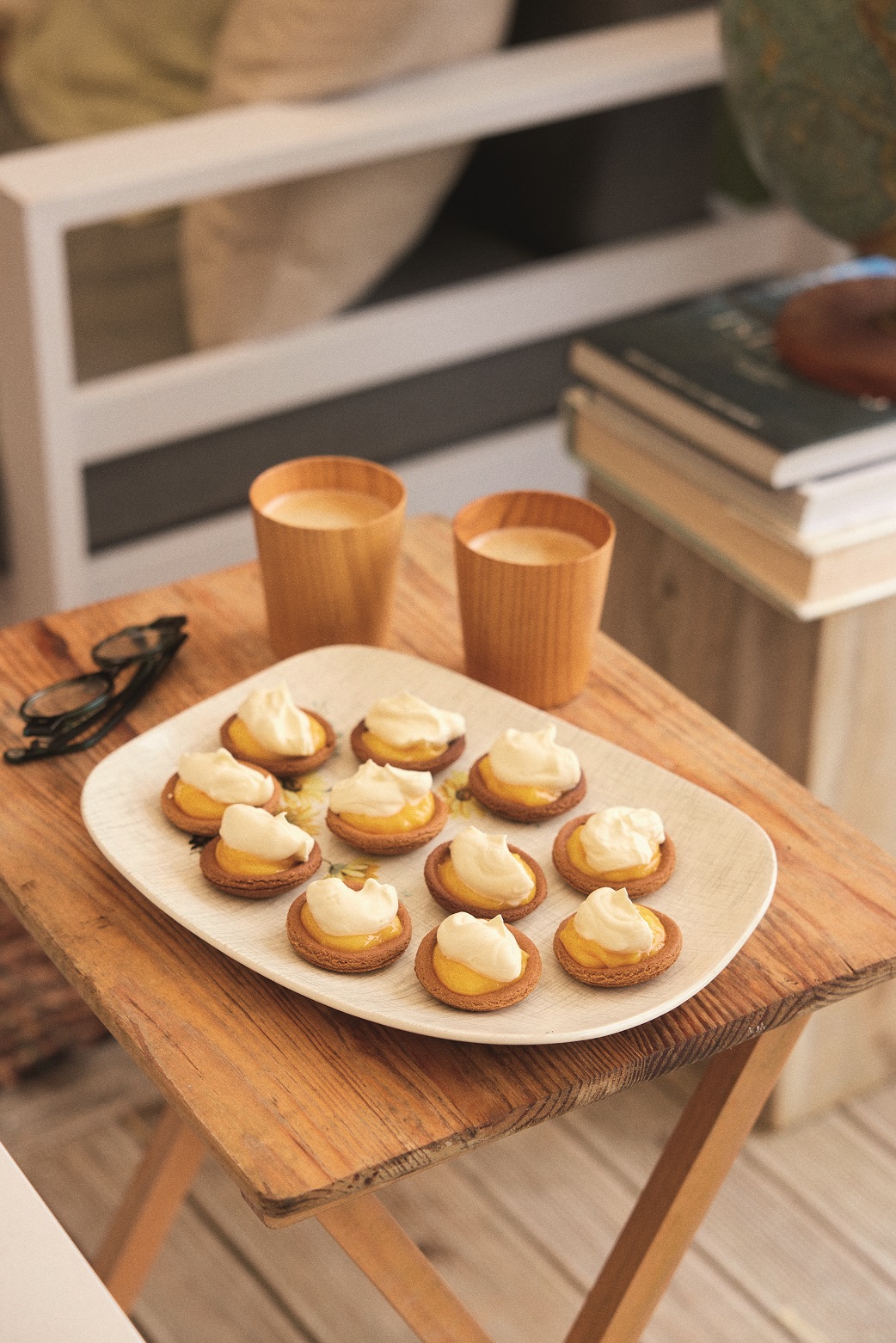 Gingernut lemon curd tarts
Gingernut lemon curd tarts

My mother used to serve these at dinner parties as a pretty posh offering back in the ’70s. As a child I would always hope there were some left over in the fridge the next morning. The gingernut bases would have softened up a bit by then, but I’d still smash one or two before breakfast. I love Griffin’s Gingernuts: quite possibly the best coffee, tea or Milo dunkers in the business.
Makes 20
Ingredients
1×250g packet Griffin’s Gingernuts
lemon curd (see below)
300ml cream (to serve)
Lemon curd
8 egg yolks
⅔ cup (140g) sugar
⅔ cup (80ml) fresh lemon juice
¼ cup (60g) butter, roughly chopped
⅓ cup (80ml) cream
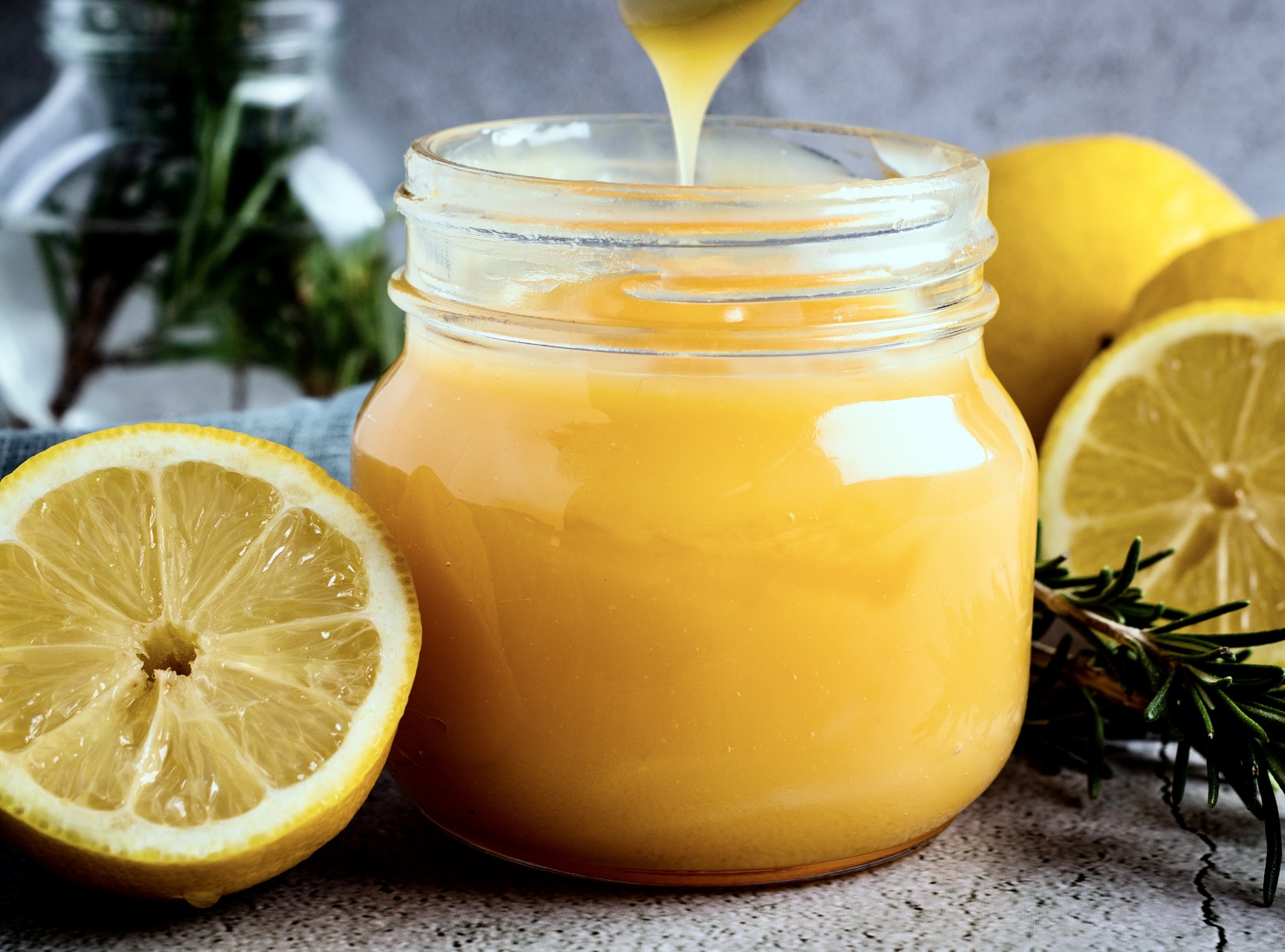
To make the lemon curd, put the egg yolks, sugar and lemon juice in a suitable-sized nonreactive saucepan. Whisk until combined.
Place the saucepan over medium heat and stir the mixture continuously with a wooden spoon, or better still a rubber spatula, until it turns into a thick curd — this will be shortly after it comes up to the boil.
Remove from the heat, stir in the butter and let the mixture cool before stirring in the cream. Pour into a jar or similar container, then refrigerate until required.
Method
Preheat your oven to 180°C .
Spread the gingernuts out on a baking tray and place in the oven for 3-4 minutes. Remove from the oven and, while they are still hot and pliable, press each one down into the hole of a small muffin tray or similar dish (once they cool, they go back to their crunchy hard selves). Repeat in batches.
Fill the tart bases with lemon curd. Refrigerate for a couple of hours to slightly soften.
To serve, whip the cream until soft peaks form and spoon a liberal amount over each tart.
Serve immediately.
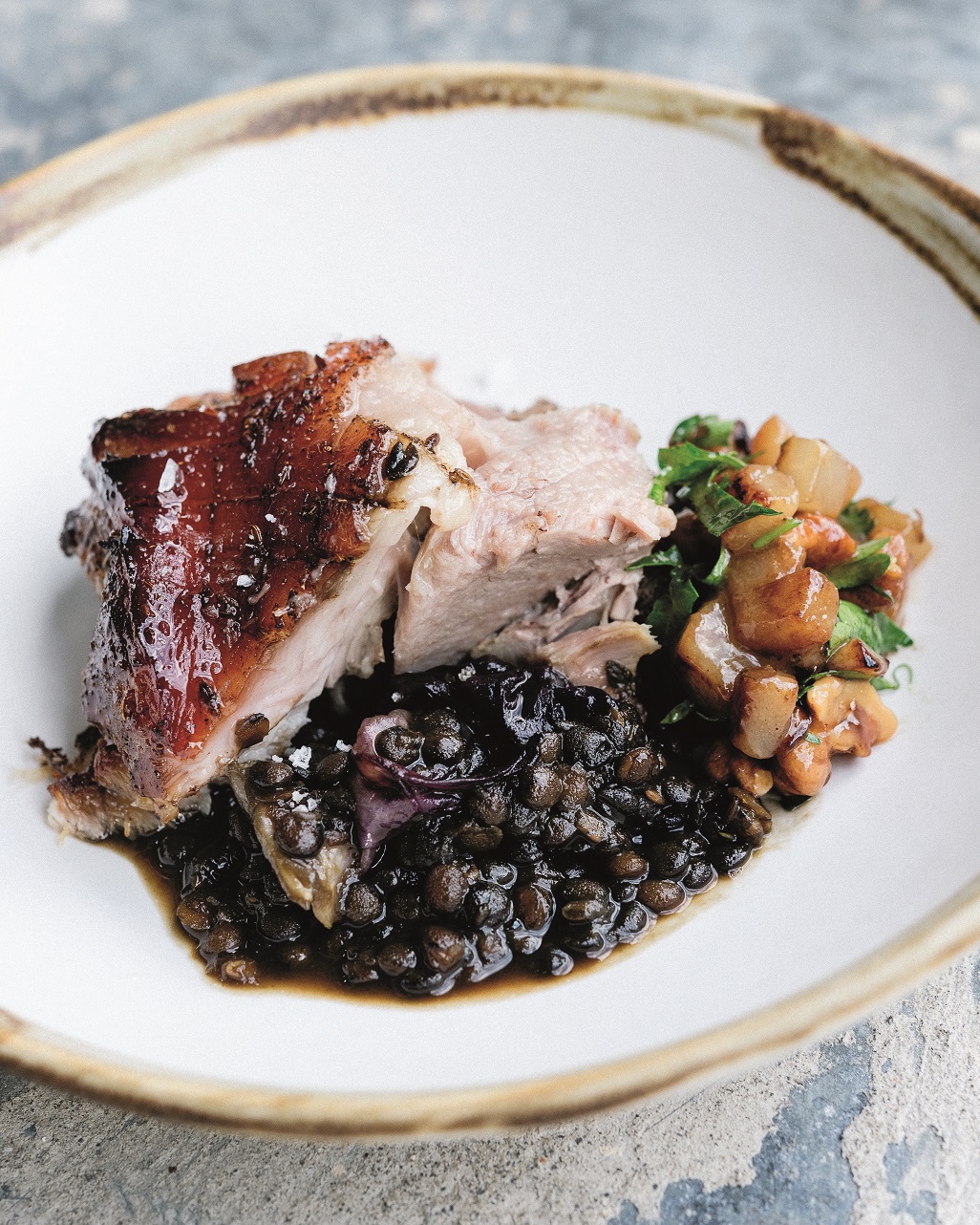 Braised pork with radicchio lentils, pear and walnut relish
Braised pork with radicchio lentils, pear and walnut relish

In my mind, this is a winter Saturday- or Sunday-night dish. I say that as this is the kind of recipe that people who love to cook will get immense pleasure from. It’s about spending the afternoon taking the time to enjoy the wonderful process of cooking something low and slow, when the most delicious of scents permeate the kitchen and intensify as the afternoon lengthens. Prepare the radicchio lentils and the caramelised pear and walnut relish while the pork is cooking. Radicchio brings bitterness to the dish, which is balanced by the fresh pear and walnut relish. This fare deserves good-quality red wine, crusty bread and a simple green salad to round out the meal!
Serves 6
Pork shoulder
1 x 2.5kg boneless pork shoulder
1 Tbsp cumin seeds, toasted and ground
1 Tbsp fennel seeds, toasted and ground
½ tsp dried chilli flakes
1 Tbsp flaky sea salt
½ tsp freshly ground black pepper
finely grated zest of 2 lemons
¼ cup (60ml) cooking oil
1 cup (125g) roughly chopped celery
1 cup (115g) roughly chopped carrot
2 cups (310g) roughly chopped onion
2 Tbsp picked and chopped thyme leaves
1½ cups (375ml) apple juice
3 cups (750ml) chicken stock
1 cup (250ml) beef stock
¼ cup (60ml) cider vinegar
¼ cup (60ml) runny honey
Caramelised pear and walnut relish
⅓ cup (80ml) sherry vinegar
2 Tbsp runny honey
1 tsp Dijon mustard
⅔ cup (170ml) walnut oil (or half olive and half canola oil)
2 Tbsp cooking oil
3 firm, ripe pears, peeled and cut into 1 cm dice
½ cup (50g) toasted walnuts, roughly chopped
¼ cup (7g) roughly chopped flat-leaf parsley
Radicchio lentils
1½ cups (325g) green lentils
6 cups (1.5 litres) chicken stock
1 head radicchio, torn into pieces
flaky sea salt and freshly ground black pepper
Method
Preheat your oven to 200°C .
Take the pork shoulder and score the skin in a criss-cross fashion with a sharp knife (I keep a Stanley knife in my kitchen drawer for this exact purpose).
Place the pork in a large bowl, then add the cumin, fennel, chilli flakes, salt, pepper and lemon zest. Massage the ingredients all over the pork. Set aside.
Place a large cast-iron casserole dish or heavy-bottomed ovenproof pan over medium-high heat. Once hot, add the oil, along with the celery, carrot, onion and thyme.
Cook the vegetables for 10 minutes or so, stirring occasionally, until dark and caramelised.
Now add the apple juice, stocks, cider vinegar and honey. Stir through, then top with the pork shoulder, skin side up. Place in the oven and cook, uncovered, for 30 minutes until the pork skin has started to caramelise. Now place the lid on the dish and turn the oven down to 160°C. Continue to cook for 2½–3 hours.
The pork shoulder is ready when it is tender and falls away when prodded.
Let cool for a bit, then carefully take the pork out of the cooking liquid. Cover with tinfoil to keep warm.
Strain off the cooking liquid from the vegetables. Reserve both.
To make the caramelised pear and walnut relish, place the vinegar, honey and mustard in a small saucepan over medium-high heat. Bring up to the boil and reduce for 2 minutes. Pour into a container, then take a stick blender and blitz while slowly drizzling in the walnut oil to form a thick and emulsified mixture. Set aside.
Place a non-stick frying pan over medium-high heat. Once hot, add the cooking oil, followed by the pears. Cook for about 5 minutes until the pears begin to caramelise. Remove and tip into a bowl. Let cool.
Add the toasted walnuts and parsley to the pears. Fold in just enough of the vinaigrette to dress the pear and walnut mixture (keep the rest for another day). Leave the relish at room temperature or refrigerate until required.
To make the radicchio lentils, wash the lentils in a sieve, then place in a large saucepan. Add the reserved braising liquid from the pork, along with half the stock. Place over medium heat, bring up to the boil, then lower the heat to a rolling simmer. As the lentils absorb the stock, keep adding more until the lentils are soft to the bite but not falling apart, about 30–40 minutes.
Once you are happy with the texture, add a little more stock so it works as a loose sauce. Now add the radicchio and cook for a couple of minutes, until nicely wilted.
Stir through the reserved pork-braised vegetables, then season to taste.
Bring the lentils up to heat, then ladle into warmed bowls. Carve or break up the pork shoulder into pieces, then place on top of the lentils. To finish off, spoon over the caramelised pear and walnut relish.
Serve immediately.
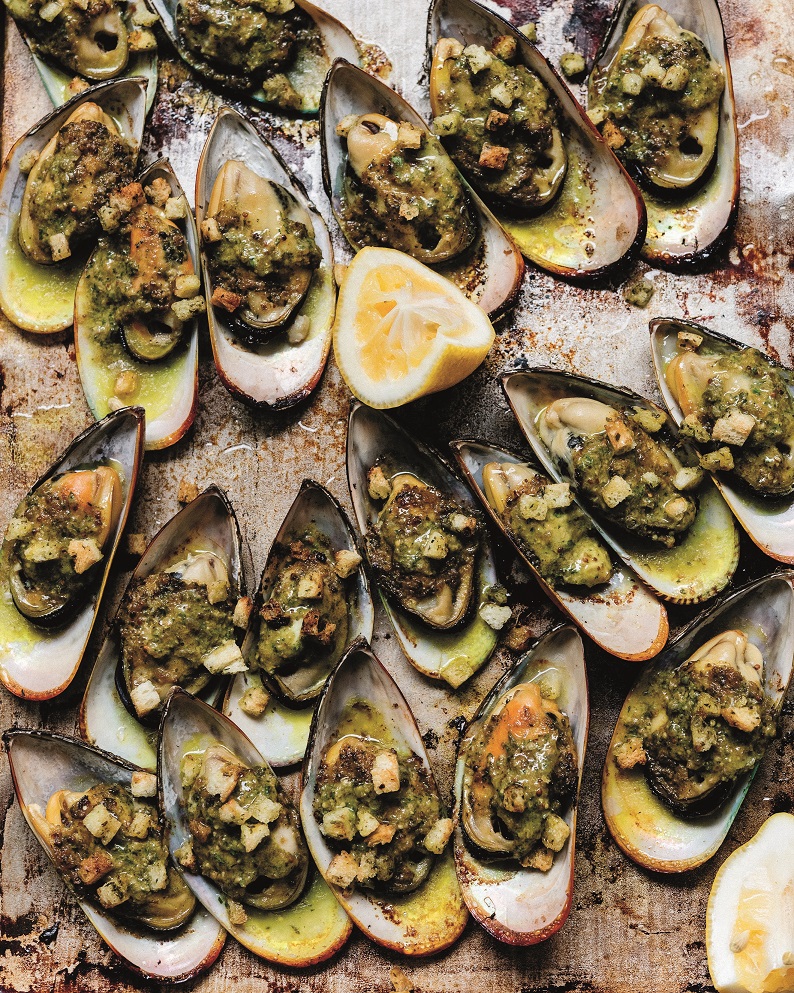 Grilled mussels with Cafe de Paris butter
Grilled mussels with Cafe de Paris butter

Cafe de Paris butter was developed in the 1940s at a restaurant in Geneva called Cafe de Paris (there’s a surprise!). I’m not sure who the chef was who came up with this crazy-good butter with a list of ingredients as long as your arm; however, I am sure glad he or she did. Traditionally served with steak, I have found that this delicious butter can be served, within reason, with practically anything savoury. Don’t be put off by the long list of ingredients, as once you assemble them all it’s actually really easy to make. Go with me on this— it’s worth the effort, and this recipe makes a good amount, so you can divide it up after you have made it and freeze the rest.
Cafe de Paris butter
1 cup (250g) unsalted butter, diced plus 2½ Tbsp extra
¼ cup (40g) finely diced shallots
1 Tbsp finely chopped garlic
2 tsp curry powder
¼ cup (60ml) white wine
2 Tbsp worchestershire sauce
1½ Tbsp dijon mustard
1½ Tbsp wholegrain mustard
pinch cayenne pepper
1 Tbsp lemon juice
2 anchovies, finely diced
2 Tbsp capers, rinsed and finely sliced
½ Tbsp finely chopped thyme
1 Tbsp each finely chopped dill, parsley, tarragon and chives
Flaky sea salt and freshly ground black pepper
Mussels
24-36 greenshell mussels
½ cup 125ml white wine
½ cup 125ml water
lemon halves for squeezing
lemon and herb croutons to serve
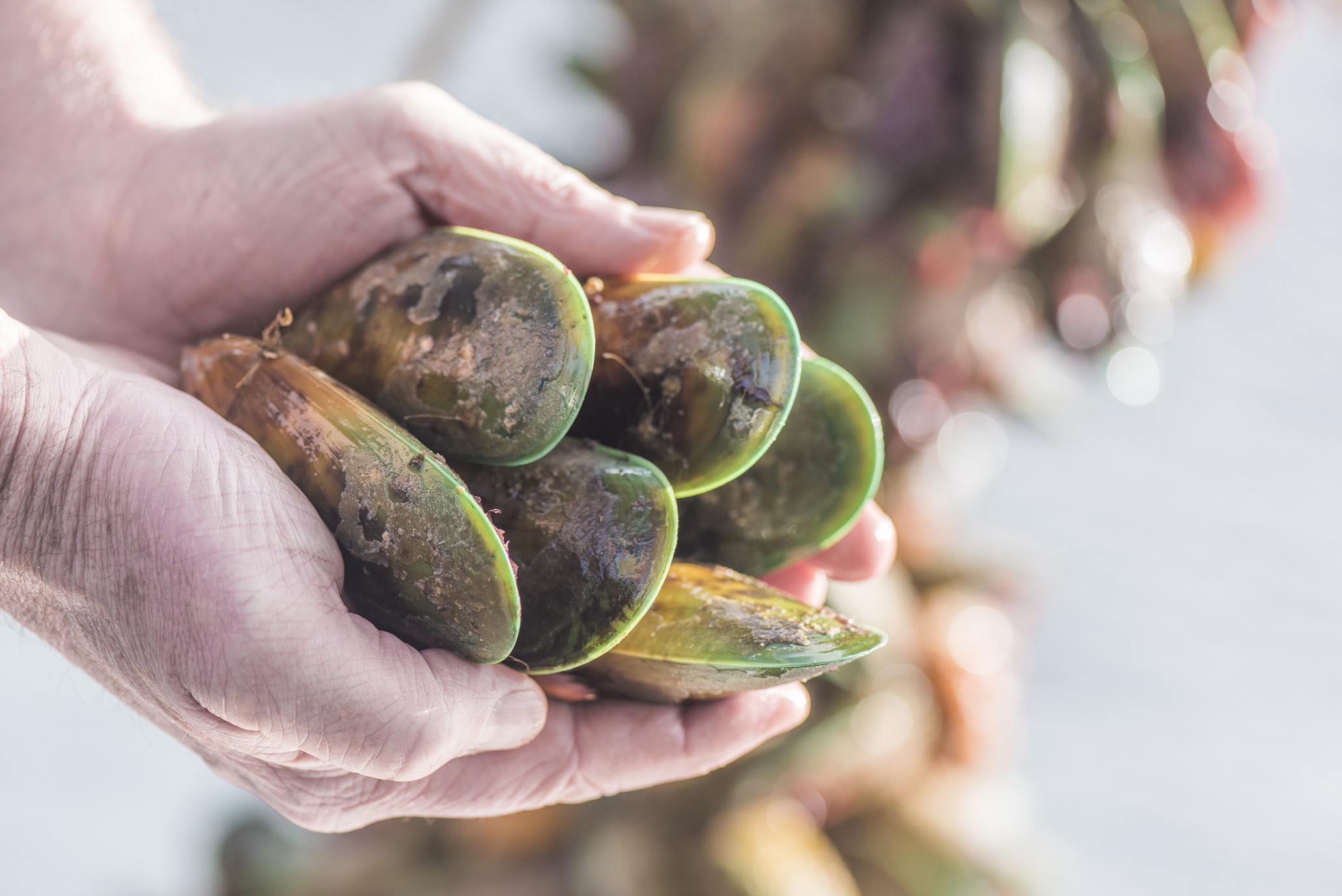
To make the Cafe de Paris butter, place a small pan over medium-low heat. Add the 2½ tablespoons butter, along with the shallots, garlic and curry powder. Sweat for 5 minutes, then pour in the wine and add the Worcestershire sauce. Cook for a further 5 minutes or so, until the liquid has reduced. Take the pan off the heat and let cool to room temperature.
Place the shallot mixture in a bowl along with the remaining ingredients. Using clean hands, work all the ingredients together until combined. Taste and season liberally with salt and pepper. Spoon out in two lots on to clingfilm and shape into two logs. Carefully wrap and twist the ends like a sausage. Freeze one log of the butter and refrigerate the other until required.
Prepare the mussels. Debeard and place in a large saucepan over high heat. Pour over the white wine and water. Give the saucepan a shake after 5 minutes, then remove the mussels one at a time as they open up. Discard any that haven’t opened. Let the mussels cool, then remove the top half of the shell and discard. Detach the mussel, then lay it back in the half shell. Refrigerate until required.
Preheat the grill. Arrange the mussels (in their half shell) on a baking tray. Slice small discs of the Cafe de Paris butter and place one on top of each mussel. Place under the grill for 1–2 minutes, or until the butter has melted and the mussels have begun to caramelise. Remove from the grill. Let cool for a couple of minutes before placing on a platter. Top with a few lemon croutons on each. Serve with the lemon halves on the side and a big pile of kitchen paper or napkins to catch the juices.
Eat immediately.











